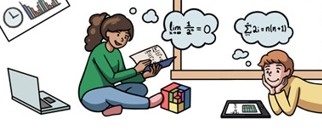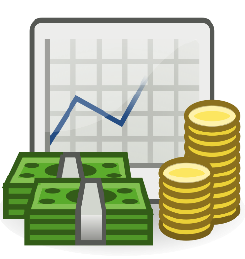Algoma University Tutoring Program

The ML CoP supported a highly promising online tutoring program for secondary school students. This program was developed by Algoma University in partnership with Algoma District School Board and the Huron Superior Catholic District School Board. In May and June, tutoring was offered to Grade 12 students from these two boards regardless if they were accepted to Algoma University. Each student tutor received 10 hours of training on how to work with school students, how to help with mathematics online, and how to be a tutoring team member. Each student tutor worked for 120 hours on activities directly related to tutoring school students (direct contact + preparation + consultation with a Coordinator of the program). The ML CoP collected data and feedback from the program, and compiled a report on the Results of the Algoma Connect Program (ACP).
The Algoma University tutoring program for secondary school students continues in the 2020-21, and the university will give course credits to the involved tutors, creating a career link-COOP certificate for those involved. This project provides a hands-on experience to assist and inspire interested Algoma University students to continue with teacher education programs and other teaching options.
Istvan Imre, Darren Vaughan and Dragana Martinovic presented on September 26, 2020 a paper titled: CONNECT-ing in the era of COVID, at the SNU Webinar on Mathematics Education in the Era of COVID-19: The Cases of South Korea, Singapore, and USA.
GECDSB Summer Learning Numeracy Program
This was a fourth year of the Mathematics Learning Leadership Project (MLLP). Five whole school teams had planned to continue their work on extending content, pedagogy and leadership learning. However, due to outbreak of Covid-19 and resulting school closures, the GECDSB conducted an online Summer Learning Numeracy Program for vulnerable Grades 1 to 5 students instead. The summer school, Camp Wonder Numeracy, had a total of 210 participants (182 students from 22 schools, 26 teachers and 2 coordinators). The ML CoP collected data and feedback from the program which focused on three aspects: student achievement, teacher efficacy and shift in practice, and characteristics of effective numeracy instruction in the virtual environment. Based on observations in the 13 numeracy digital classrooms during the Summer Learning Program, the following teacher moves were determined to be instrumental in creating effective mathematics instruction:
- Establish norms and expectations for classroom engagement
- Establish and communicate clear learning objectives
- Select a task or provocation that is relatable, inquiring and promotes problem solving
- Use student voice predominantly
- Have a visual component present.
The GECDSB Summer Learning Program confirmed that in 14 days and 14 hours of synchronous numeracy instruction, most students demonstrated gains in understanding and skills related to early fraction concepts. Through contexts of fair‐sharing and the use of fraction models, most students showed improvement between the pre- and post-assessment, some students even shifting by as many as 7 points.
In the remote classroom environment, having a teaching partner was critical. The narrow focus on fractions supported teacher content knowledge and efficacy, likely increasing the impact on student achievement. The ML CoP team concluded in their Mathematics Leadership Learning at GECDSB report that with a common focus, the instructional leaders can create professional development opportunities to deepen both pedagogy and content knowledge.
TDSB’s Math Action Plan
The ML CoP also supported TDSB’s Math Action Plan – Focusing on mental math, with the goal to create parent resources and online staff supports on the TDSB external web-page. On a biweekly cycle, virtual PD sessions for teachers/administrators focused on the “how many ways can you solve a question using mental math” and “find your own strategy”. Based on the experiences of the virtual PD sessions and feedback from all involved, a final video was created and shared with a wider audience. The video serves as a general introduction video for parents about mental mathematics and contain quick tips about how to engage in mental mathematics for home learning. This project stemmed from Ontario’s priority of fundamental mathematics. The project was focused on supporting teachers and families by utilizing collaborative design that brings together classroom experts and research recommendations regarding numeracy instruction. Parental support was achieved through outputs of PD sessions with teachers, coaches and research academics.
 Financial Literacy Lesson Plans
Financial Literacy Lesson Plans
Four lesson plans for Financial Literacy during the pandemic (Grades 6-8):
- Lesson 1: Nutrition in a Pandemic
- Lesson 2: Storage Space in a Pandemic
- Lesson 3: Cooking vs. Ordering Food in a Pandemic
- Lesson 4: Savings in a Pandemic
Collaborative Inquiry
The paper, Why Do Schools Need Collaborative Inquiry? A Perspective from a District Researcher, was published in March 2020 on the MKN website. The Collaborative Inquiry (CI) paper, accompanied by an info-graphic, from the researcher Brandy Doan (HWDSB), explored what is Collaborative Inquiry and what it is not, and provided examples how it supports teaching of mathematics with technology. Doan writes how “The CI is philosophically based on a continual pursuit of greater precision, personalization, and innovation of instructional practice to address student learning. Thus, CI is an excellent model for introducing change in teacher practice such as new digital tools or paradigms.” In her document, Doan dissects the problem of one school in which “students struggle to clearly and explicitly communicate and demonstrate their thinking and understanding during mathematical problem solving. [Through Collaborative Inquiry] Teachers would like to know if the use of Accountable Talk in their junior division will help their students in this matter and consequently increase mathematics achievement.”
The Math Leadership page on the website had a total of 966 visits.
